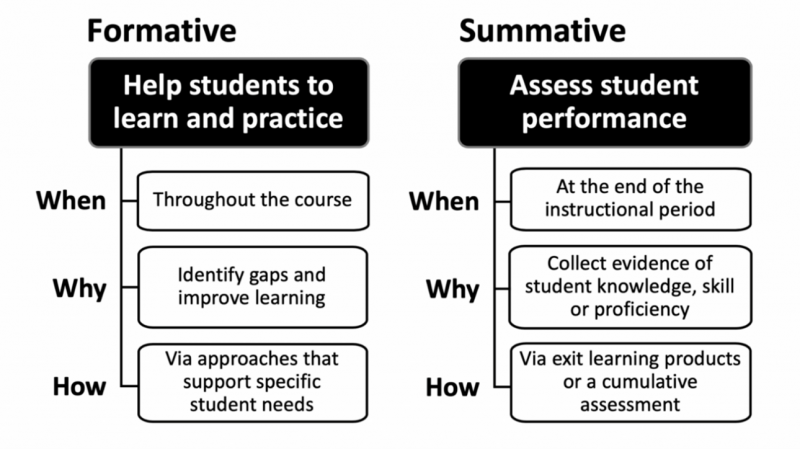Assessments: Getting it Right!

 Student assessment is a critical aspect of the teaching and learning process. It is important for instructors to strategically evaluate the effectiveness of their teaching by measuring the extent to which students in the classroom are learning the course material.
Student assessment is a critical aspect of the teaching and learning process. It is important for instructors to strategically evaluate the effectiveness of their teaching by measuring the extent to which students in the classroom are learning the course material.
Any student pursuing any course of study will be evaluated in some way. Similarly, each member of the teaching staff will be involved in assessment-related tasks at some time. Assessment consumes a big percentage of your time, and for students, it may be a key predictor of why, when, and how they learn. As a result, getting evaluations ‘right’ is critical, both for your students and for you.
Formative vs. Summative Assessments
Formative assessments are used to measure progress toward a learning objective. Both the instructor and the student can keep an eye on this progress throughout the course. The continual use of formative assessments provides us with an indicator of how well students are progressing toward the learning target. For students to progress, it is essential that they can recognize and correct frequent misunderstandings. This type of evaluation, known as ‘assessment for learning,’ is designed to help students enhance their understanding and foster a sense of responsibility.
Summative assessment, on the other hand, refers to “assessment of learning” or “exam or evaluation.” It is common for summative assessments to take place towards the end of a course or unit, and they are designed to show how much students have learned. This means that summative assessments may account for a larger percentage of the grade in that program. Formative and summative assessments are often used together by instructors because they may be used in effective ways to evaluate students.
Kurt & Kurt (2020) described the when, why, and how of formative and summative assessments in the graphic below.

Ideas for Formative and Summative Assessment Activities
The “how” of formative assessment can be a challenge, the goal of any activity should be to provide quality feedback for the student to learn. The following are examples of activities that may be used to provide this engaging feedback for your students. Always remember that any activity should be aligned with an objective for the module and course.
Formative Assessment Activities
- Exit Tickets–These are short questions pertaining to topics in the module and are placed at the end of the module before the student exits. An example would be for the student to describe in 3-4 sentences what the lesson or module was about.
- Group Thinks – Students work in pairs or small groups to solve a problem or answer a question relating to the reading they have been assigned. Students are first asked a question concerning the material by their instructor. As a follow-up, students work in groups of two or more to brainstorm ideas for how to answer the question at hand. As a final step, each group presents its findings to the class.
- Opinion Polls – Students express their level of agreement or disagreement with a certain prompt or statement. This activity enables instructors to assess students’ comfort levels with reference to the primary objectives of learning activities and specific course content. This can be done with polling software such as Poll Everywhere.
Summative Assessment Activities
- Papers Written by Students– Papers are a helpful assessment tool when you wish to investigate higher-level thinking and grasp of course material, as is the case with essays. Consider assigning an assignment or paper, if you want to see your students practice analysis, application of the material in the form of an argument or thesis, engagement with opposing viewpoints, or flex their own creative muscles in relation to course material and assignments. These papers can be submitted online, and you can provide your feedback with the grading tools of Canvas and Turnitin. You also can use grading rubrics.
- Examinations– Examinations can take many various forms, and the most crucial step is to determine which types of questions will be most effective in determining if students grasp course concepts in the way you wish them to be understood. Essays, problems to be solved, multiple-choice, completion (fill-in-the-blank), matching, and short response questions are examples of question kinds available.
- Research Project– Have students prepare a research topic relating to your course for their summative assessment. Have them create a rough outline of the project proposal they would like to submit and then with your approval have them complete the project. Provide a rubric with specific criterion as a guide for students to follow.
If you use assessments strategically in your course by using both formative and summative styles throughout your course, you are certainly contributing to your student’s chance of success.
References
Kurt, S., & Kurt, D. S. (2020, November 11). Formative And Summative Assessment – Educational Technology. Educational Technology. https://educationaltechnology.net/formative-and-summative-assessment/.
20 Formative Assessment Examples for Classrooms. (2021, June 29). Top Hat. https://tophat.com/blog/formative-assessment-example.
Summative Assessment Ideas | Center for Transformative Teaching. (n.d.). Summative Assessment Ideas | Center for Transformative Teaching. https://teaching.unl.edu/summative-assessment-ideas/.